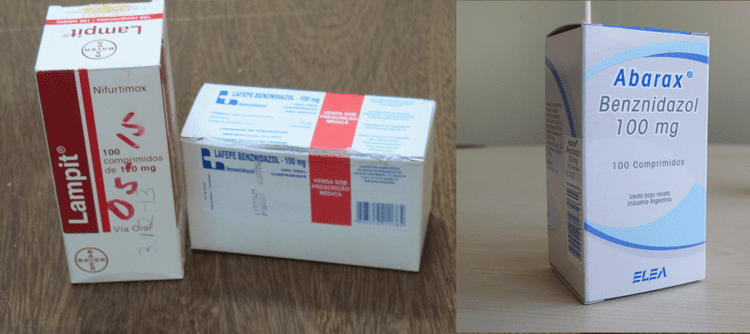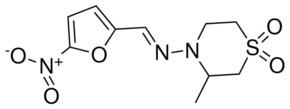Trade names Lampit Routes ofadministration By mouth | Pregnancycategory Undetermined Molar mass 287.293 g/mol | |
 | ||
AHFS/Drugs.com Micromedex Detailed Consumer Information ATC code P01CC01 (WHO) QP51AC01 (WHO) Legal status In general: ℞ (Prescription only) | ||
Nifurtimox is a medication used to treat Chagas disease and sleeping sickness. For sleeping sickness it is used together with eflornithine. In Chagas disease it is a second line option to benznidazole. It is given by mouth.
Contents
- Medical uses
- Pregnancy and breastfeeding
- Side effects
- Contraindications
- Mechanism of action
- Manufacturing and availability
- Research
- References

Common side effects include abdominal pain, headache, nausea, and weight loss. There are concerns from animal studies that it may increase the risk of cancer but this concerns have not be found in human trials. Nifurtimox is not recommended in pregnancy or in those with significant kidney or liver problems. It is a type of nitrofuran.

Nifurtimox came into medication use in 1965. It is on the World Health Organization's List of Essential Medicines, the most effective and safe medicines needed in a health system. It is not available commercially in Canada or the United States. In the United States the medication can be gotten from the Center for Disease Control. It cost about 20 USD for a course of treatment as of 2013. In regions of the world where the disease is common nifurtimox is provided for free by the World Health Organization.

Medical uses
Nifurtimox has been used to treat Chagas disease, when it is given for 30 to 60 days. However, long term use of Nifurtimox does increase chances of adverse events like gastrointestinal and neurological side effects. Due to the low tolerance and completion rate of Nifurtimox, benznidazole is now being more considered for those who have Chagas disease and require long term treatment.

Nifurtimox has also been used to treat African trypanosomiasis (sleeping sickness), and is active in the second stage of the disease (central nervous system involvement). When nifurtimox is given on its own, about half of all patients will relapse, but the combination of melarsoprol with nifurtimox appears to be efficacious. Trials are awaited comparing melarsoprol/nifurtimox against melarsoprol alone for African sleeping sickness.

Combination therapy with eflornithine and nifurtimox is safer and easier than treatment with eflornithine alone, and appears to be equally or more effective. It has been recommended as first-line treatment for second-stage African trypanosomiasis.
Pregnancy and breastfeeding
Use of nifurtimox should be avoided in pregnant women due to limited use. There is limited data shown that nifurtimox doses up to 15 mg/kg daily can cause adverse effects in breastfed infants. Other authors do not consider breastfeeding a contraindication during nifurtimox use.
Side effects
Side effects occur following chronic administration, particularly in elderly people. Major toxicities include immediate hypersensitivity such as anaphylaxis and delayed hypersensitivity reaction involving icterus and dermatitis. Central nervous system disturbances and peripheral neuropathy may also occur.
Most common side effects
Less common effects
Contraindications
Nifurtimox is contraindicated in people with severe liver or kidney disease, as well as people with a background of neurological or psychiatric disorders.
Mechanism of action
Nifurtimox forms a nitro-anion radical metabolite that reacts with nucleic acids of the parasite causing significant break down of DNA. Its mechanism is similar to that proposed for the antibacterial action of nitrofuran agents. Nifurtimox undergoes reduction and creates oxygen radicals such as superoxide. These radicals are toxic to T. cruzi. Mammalian cells are protected by presence of catalase, glutathione, peroxidases, and superoxide dismutase. Accumulation of hydrogen peroxide to cytotoxic levels results in parasite death.
Manufacturing and availability
Nifurtimox is sold as Lampit by Bayer. It was previously known as Bayer 2502.
Nifurtimox is only licensed for use in Argentina and Germany, where it is sold as 120-mg tablets. It is not commercially available in the United States, but can be distributed to qualifying healthcare professionals by the Centers for Disease Control and Prevention Drug Service.
Research
Nifurtimox is in a phase-II clinical trial for the treatment of pediatric neuroblastoma and medulloblastoma.
